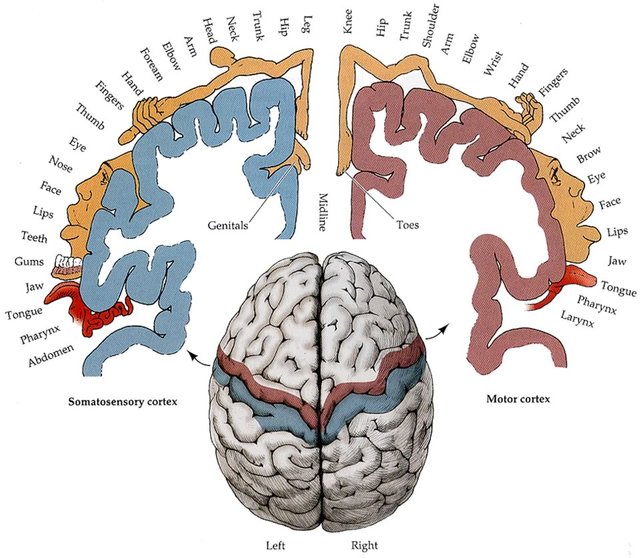Homunculus

How your brain sees your body:
Don't scroll to the bottom yet.... first the history and science.
Our brain is a marvel in how it operates and operates all else. And in the 1950s, Wilder Penfield (OM CC CMG FRS) a pioneering neurosurgeon, was performing surgeries on patients that suffered with intractable epilepsy in hopes of curing them.
He discovered that before an epileptic seizure, patients experience what is called an "aura." This was a warning that a seizure was about to occur. He further postulated that if he could provoke an aura with a mild electric current to the brain, then could locate and remove the source of the seizure he would eliminate the epilepsy. So while patients were fully conscious, (and anesthetized), he opened the patients skulls and worked to pinpoint the source of the disease.
While he had access to living brain, he began side experimentation a bit. While he probed the brain he gathered data on which parts of the cerebral cortex control which voluntary body functions and/or feelings. His discovery was that the brain had a largely distorted view of the body.
To his credit, the technique was often successful, but his it was his extra experimental methods that led him to an even more dramatic discovery. What he found was that by stimulating the cerebral cortex in any location, it would bring phyisical responses. But he also found that by stimulating portions of the temporal lobes (which are the lower portions of the brain on each side) could he elicit relevant and integrated responses. He found that memory, sound perception, movement, and color distinction could be activated. He further found that these memories were far more distinct than normal memoryies.
In the process, he developed a map of the brain portrayed as a cartoon called the "motor homunculus" (a miniature human figure).
The enlarged lips, head, hands, feet and other body parts are in relation to the abundance of sensory neurons in these areas.

Did you know?
We all realize what bodies look like from the outside or one brain imaging of another. This little caricature is called a cortical homunculus and it is how your brain percieves your own body from the inside.
In other words, if our body parts were in the same proportion as our brains cortex's represented them, we would look like this!
Just thought you would like to know

Image Credits: laughteronlineuniversity.com, e-monsite.com
This post has been ranked within the top 50 most undervalued posts in the first half of Dec 26. We estimate that this post is undervalued by $4.56 as compared to a scenario in which every voter had an equal say.
See the full rankings and details in The Daily Tribune: Dec 26 - Part I. You can also read about some of our methodology, data analysis and technical details in our initial post.
If you are the author and would prefer not to receive these comments, simply reply "Stop" to this comment.
Oh My!! It is quite interesting to see that genitals are such a small part, while everybody make such a big deal of it. A question really to ponder... And what about the heart?
These are the motor skills not the autonomic (automatic) functions @nadversion56, as for the genitals...maybe that is in the individual rather than the general,however many people use the hands more.
Ah ok the heart is out of the picture on this one. Yes we do use the hands more.... thanks for the clarification.
It could be interesting I will look into some sources , what could some good books for neurosurgical knowledge or principles ?
Start with a free online research session... there is a ton out there.